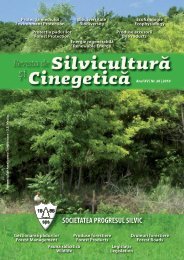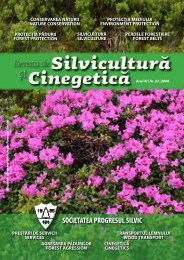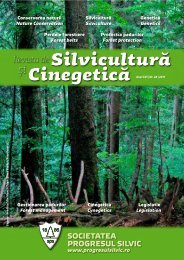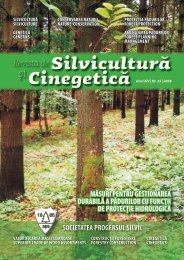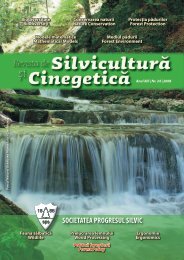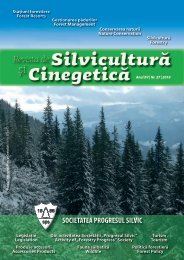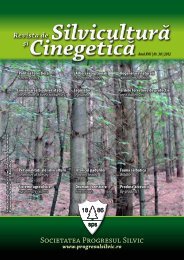Silviculture and Cinegetics Review - Societatea Progresul Silvic
Silviculture and Cinegetics Review - Societatea Progresul Silvic
Silviculture and Cinegetics Review - Societatea Progresul Silvic
Create successful ePaper yourself
Turn your PDF publications into a flip-book with our unique Google optimized e-Paper software.
FORESTRY BELTS SILVICULTURE AND CINEGETICS REVIEW XVII/30/2012<br />
erosion protection works (Anonymous 1987, 1984,<br />
2001, Burcea et al. 2007, Maruşca 2008).<br />
(i) Improvement works include, in turn, anti-erosion<br />
works, improvement of the air hydric regime through<br />
drainage, scarifying, removing unwanted woody<br />
vegetation etc., correction of soil acidity,<br />
improvement of saline soil characteristics <strong>and</strong> more.<br />
(ii) Regeneration of grassy carpet, through surface<br />
action is achieved by two groups of works:<br />
fertilization <strong>and</strong> overseeding. If fertilization (chemical<br />
<strong>and</strong> organic or by grazing) is carried out properly, in<br />
time it provide a grassy carpet regeneration,<br />
evidenced by increasing productive potential, but<br />
mainly through a favorable evolution direction. It is<br />
applied on pastures, where the soil has over 80%<br />
coverage with herbaceous vegetation <strong>and</strong> where<br />
valuable species have high participation (75%).<br />
Overseeding is recommended on areas where the soil<br />
has coverage of 60-80% with vegetation or when<br />
unworthy species have a shareholding of less than 25-<br />
30%. It also is recommended in situations where<br />
because of slope or soil the total seeding regeneration<br />
cannot be applied. In this case is performed deep soil<br />
plowing through partially destruction of sod, possibly<br />
preceded by fighting unworthy species (chemical or<br />
mechanical) <strong>and</strong> completing of the grassy carpet with<br />
valuable species, using appropriate methods.<br />
Sowing st<strong>and</strong>ard will be lower than the total st<strong>and</strong>ard<br />
used for regeneration by 25-30%.<br />
(iii) Total regeneration by seeding is applied to<br />
surfaces where the soil has less than 60% coverage<br />
with vegetation or the unworthy species have a<br />
greater than 25-30% participation, on flat or slightly<br />
sloping l<strong>and</strong>, with reduced difficulties of<br />
mechanization (slopes less than 140). Complete<br />
destruction of the grassy carpet is carried out <strong>and</strong><br />
sown meadows are set up, using specific technology.<br />
(iv) Erosion protection works are required on surfaces<br />
with large slopes (over 300), where the soil is poorly<br />
covered with vegetation or areas where intervention<br />
<strong>and</strong> exploitation works can trigger serious erosion<br />
processes.<br />
In all cases, determining the type of fertilizers <strong>and</strong><br />
amendments, of doses <strong>and</strong> ages of the application<br />
must be linked to agrochemical soil characteristics<br />
<strong>and</strong> with the mode of operation, the indicated doses<br />
for each typological unit being approximate.<br />
A successful forest pastoral system requires<br />
knowledge of growth characteristics of grass <strong>and</strong><br />
forage species, of timing, duration of grazing, grazing<br />
capacity <strong>and</strong> optimal loading with animals, to avoid<br />
degradation of pastures, through impoverishment <strong>and</strong><br />
deterioration of forage species <strong>and</strong> seedlings damage.<br />
Trees have a determining role in pastures increasing<br />
productivity <strong>and</strong> ensure better living conditions for<br />
livestock.<br />
There are many important elements justifying revival<br />
<strong>and</strong> development of forest pastoral systems in our<br />
country. Among them the fact that forest pastoral<br />
systems have a tradition in many countries, where<br />
they developed <strong>and</strong> improved, <strong>and</strong> bringing<br />
significant, ecological, economic <strong>and</strong> social benefits.<br />
4. Instead of conclusions<br />
Different agroforestry systems are traditionally used<br />
in many parts of the world, which shows that some of<br />
them have already passed the test of practical<br />
experiment. In the near future are expected to be<br />
adopted widely, such systems being easier to adapt to<br />
climate <strong>and</strong> / or technology changes in agriculture <strong>and</strong><br />
forestry (which includes the development of new<br />
technologies) or socio-economic <strong>and</strong> / or<br />
environmental changes.<br />
Advantages of agroforestry systems consist of<br />
complex l<strong>and</strong> use, both in terms of agriculture <strong>and</strong><br />
forestry, ensuring sustainable management of natural<br />
resources. They can provide products <strong>and</strong> services of<br />
the most diverse: food for humans, animal feed,<br />
wood, fruits <strong>and</strong> seeds of trees <strong>and</strong> shrubs, leaves for<br />
sericulture, flowers for apiculture, flowers, fruit <strong>and</strong><br />
bark for medicinal tea, tannin for industrial<br />
processing, mushrooms, plus the environmental<br />
benefits (improving the climate <strong>and</strong> soil carbon<br />
storage, l<strong>and</strong>scape beautifying etc.).<br />
However, without systematic research in terms of the<br />
pedo-climatic conditions of our country, the easiest<br />
way to test the utility of agroforestry systems is their<br />
practical application by l<strong>and</strong>owners. The reason why<br />
one should opt for agroforestry systems is that the<br />
mixing in time <strong>and</strong> space of forest species with<br />
agricultural ones may be, under certain conditions,<br />
more profitable, from an ecological, economic <strong>and</strong><br />
social point of view, than the separate cultivation of<br />
forest <strong>and</strong> agricultural species. To identify these<br />
conditions is necessary to know the biological<br />
interactions between the two cultures, on the one h<strong>and</strong><br />
<strong>and</strong> economic <strong>and</strong> social issues, posed by these<br />
culture systems, on the other h<strong>and</strong>, given that<br />
beneficial biological <strong>and</strong> economic interactions<br />
(whose effects are manifested in the long run) define<br />
71



